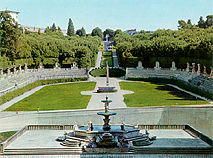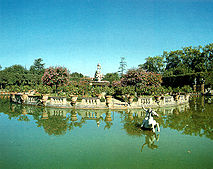
The Boboli Gardens, Amphitheatre
As soon as the Medici bought the Pitti
Palace in 1550, work got under way to enlarge it; at the same time
work also started on laying out the park behind the building, which
was planned to occupy a scenographic setting on the slopes of the Boboli
hill (covering 320.000 square metres) and also had access from the square.
Its name probably came from the "Borgoli" or "Borgolini" family,
who owned houses and land in this part of Oltrarno (literally "over
the Arno"), close to the church of Santa Felicita. However the land
and the farm that once stood on it belonged to the De' Rossi family
when Luca di Bonaccorso Pitti bought it in 1418.
The Boboli Gardens
were not to become famous until they became the property of the Medici
family, who called in Niccolò
Pericoli, known as Tribolo, to design them;
this artist had already given ample proof of his talent with his designs
for the gardens of the Medici Villas of Castello and Petraia.
Tribolo created a masterpiece of "landscape architecture" in the
Boboli Gardens between 1550 and 1558, the year of his death.

The
Pond of Isolotto
His design was used as a basis for all the royal gardens in Europe,
including Versailles, while the park itself was immediately enriched
with many Mannerist inventions by Buontalenti (like the Grotta Grande),
fountains and statues by Ammannati, Giambologna and
Tacca and eventually completed by Giulio and Alfonso Parigi (1631- 1656).
The two architects, father and son, carried out the stone Amphitheatre,
the unique setting for many celebrated theatrical performances, the cypress
alley known as the "Viottolone"
and the square and pool of Isolotto. The last additions, like the
Coffeehouse (1774-76), the Lawn of the Columns (1776) and the Lemonary
(1785), were installed by the Lorriane family who, in the 19th
century, introduced several changes in various parts of the park,
as decreed by the Romantic "English garden", then in
vogue. Pietro Leopoldo decided to open the garden to the public
in 1776.
The Giardino del Cavaliere, or Garden of the Knight, a solitary and
private area in the grounds, can be found at the top of the hill, close
to Fort Belvedere, with the small palace that
today houses the Porcelain Museum.
